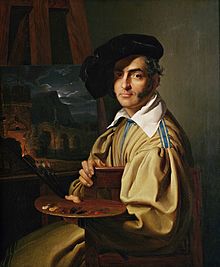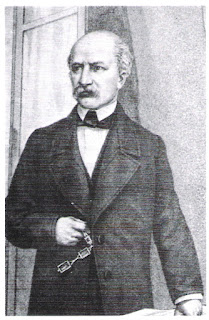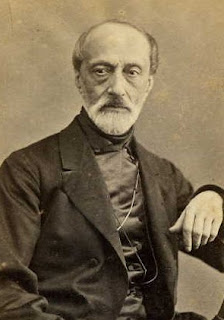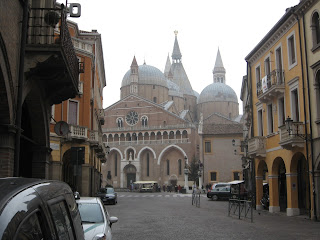19th century artist captured many beautiful views for posterity
 |
| Giuseppe Molteni's 1829 portrait of Giovanni Migliara |
He was first apprenticed to the sculptor Giuseppe Maria Bonzanigo, but then went on to study at the Brera Academy.in Milan with Giocondo Albertolli.
He began working as a set designer with Teatro Carcano in Milan in 1804 and then moved to La Scala in 1805, where he served under the direction of Alessandro Sanquirico until 1809. His theatre work enabled him to acquire skills as a landscape artist and a creator of perspective.
Migliara had to stop working while he was suffering from a serious lung problem but from about 1810 he started painting miniatures and then moved on to watercolours and then oils on canvas, silk and ivory, drawing inspiration from Venetian painters.
In 1812 he exhibited four views of Milan at the Brera Academy, officially signalling his return to the world of art.
 |
| Migliara's Veduta di Piazza del Duomo in Milan is part of the Fondazione Cariplo collection |
As his fame spread, he received commissions from the King Charles Albert, from Maria Cristina of Savoy, from Leopold II, Grand Duke of Tuscany, from Maria Louise, Duchess of Parma, from Archduke Rainer, Viceroy of Lombardy-Veneto and from the Prince of Metternich.
In 1822 he was named professor at the Brera Academy. Among his pupils were Giovanni Renica of Brescia, Luigi Bisi and Federico Moja.
Migliara took long trips to Tuscany, Piedmont, Lazio and Campania between 1825 and 1835, which gave him new subjects for his landscapes and interiors.
After being presented with the Civil Order of Savoy, a type of knighthood, by Charles Albert, he was named painter to the crown in 1833.
Migliara died in Milan in 1837, having suffered a recurrence of his lung problems. The funeral took place in the church of San Babila before his coffin was escorted to the cemetery by a military band and followed by more than 300 friends and colleagues.
Some of his paintings, including his 1928 Veduta di Piazza del Duomo in Milano, and his earlier Veduta del chiostro di Sant’Antonio a Padova, are among the Fondazione Cariplo collection at the Gallerie di Piazza Scala, located in the Palazzo Brentani and the Palazzo Anguissola, in Piazza della Scala in Milan.
 |
| Piazza del Duomo in Alessandria, the city in Piedmont where Giovanni Migliara was born in 1785 |
Alessandria, where Migliara was born, is a city in Piedmont, about 90km (56 miles) southeast of Turin. The Battle of Marengo was fought in 1800, when Migliara would have been 15, between French and Austrian forces on a battle field to the east of Alessandria. The French victory helped to consolidate Napoleon’s grip on power back in Paris. Alessandria has a Museum of the Battle of Marengo in Via della Barbotta in the district of Spinetta Marengo. Alessandria is also a rail hub for northern Italy. The railway station opened in 1850 to form part of the Turin to Genoa railway and now also has lines to Piacenza, Novara, Pavia, Cavallermaggiore, Ovada and San Giuseppe di Cairo.
 |
| The Palazzo di Brera in Milan, where Migliara was a student and later a professor |
One of Migliara’s most famous paintings is a view of the Palazzo di Brera in Milan, which he executed in 1829 after he was named as a Professor at the Art Academy there. Palazzo di Brera was a Jesuit college from the 1570s to the 1770s. After that it became home to various cultural, scientific, and artistic institutions. Maria Theresa of Austria founded the Reale Accademia di Belle Arti there in 1776. The picture gallery, now the Pinacoteca di Brera, was opened in 1806. The Brera district is often recommended to visitors to Milan as an area where there are plenty of good restaurants.
Also on this day:
1704: The moment that inspired Edward Gibbon to write his epic history of Rome
1905: The birth of footballer Angelo Schiavio
1964: The birth of astronaut Roberto Vittori
Home











